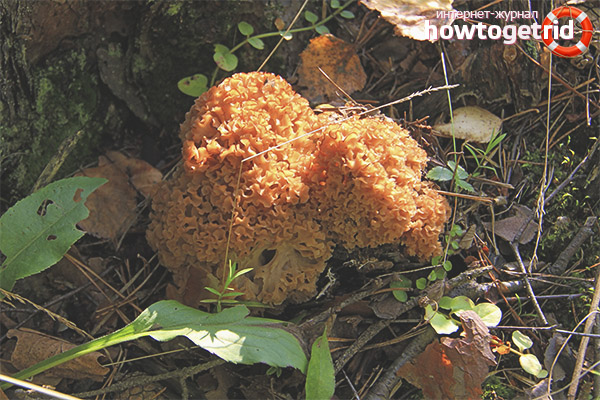The content of the article
Curly sparassis is understood in the literal sense of the word as a curly beige mushroom, which belongs to the sparass family. There are no more than 7 varieties in this family, which is noteworthy. The mushroom is an edible and very tasty variety, but it is listed in the Red Book of our country as an endangered type. Due to deforestation and gathering by people, the presented specimens are becoming smaller. Today we will study everything related to them.
Description
- Once again we repeat that this variety is classified as edible. The mushroom attracts attention, first of all, due to the fact that it is famous for its external data. In common people it is called in different ways, including mushroom cabbage, lamb mushroom, mushroom happiness, as well as rabbit cabbage and king mushroom. Moreover, the name "lamb" is used only in foreign reference materials, our compatriots practically do not express themselves like that. Russian experts mean by a lamb a completely different mushroom - curly griffin.
- Now consider the description of the presented intricate instance. The fruit body is based on multiple curly leaves that branch and look like a shrub. The mushroom is large enough, its wrinkled lobes with wavy edges cannot go unnoticed. Considering the diameter, it can be said that some fruiting bodies grow up to 20-60 cm. Of course, this is rare, on average mushrooms are found in the diameter of 7-30 cm. The bush is about 20 cm in height and exceeds 6-8 kg in weight . Some mushroom pickers came across specimens of 10-14 kg.
- Fruit bodies in shade are beige, yellow-white. In mature specimens, the color is dark, brownish with reddish blots. The base is poorly visible, it is root-shaped, attached to the center of the body. The leg is about 5 cm in thickness. For the most part, it is dug into the ground, therefore it is not visible. It grows up to 13 cm in length, turns white-yellow, can darken and turn black when overripe.
- The soft part of the peculiar wavy blades is fragile, easily crumbles and breaks. In grown fruit bodies, it is hard and hard. It tastes nutty, it smells strange. The smell has nothing to do with the mushroom aroma. Reproduction is carried out by spores of an elliptical shape, in color they are light with yellow or white.
- The layer, which is otherwise called spore-bearing, prefers to be located on every blade. Moreover, it occupies only one side, not fully revolving. By shade, this layer is pigmented with creamy white or gray. Feels a little rough, and may be excessively smooth.
Growth
- Mushrooms of the discussed family prefer to live in the Northern Hemisphere. They are met in formed coniferous and mixed foxes with broad-leaved trees. Usually located near Khabarovsk, Krasnodar, Altai, Karelia, Moscow, Sakhalin, Chelyabinsk. They are also not rare in the Caucasus, in Primorye. Naturally, it cannot do without Georgia and North America, Asia and the Baltic states.
- Fruiting originates in August and ends in September. Here is such a short crop season. These fungi are classified as parasites, that is, they settle on the roots of trees and gradually destroy them. Growth is carried out singly among the pines, but fungal colonies can be found in other coniferous bands. They are found in larches, cedar wood and next to fir.
- In some climatic zones, these fungi prefer to be located on stumps that are associated with the base of the tree and its root system in particular.This variety of sparassis can cause the death of plants due to the development of brown-red rot.
Edibility
- Discussed fruiting bodies belong to the category of edible mushrooms. Often such instances are included in the recipe for soups and fried foods. Also, such fruits are often dried. Separately, it is worth noting that only young specimens can be taken as food.
- The problem is that with age, mushrooms become too stiff. They also turn brown and become unbearably bitter. As for the young fruits, they have an excellent taste. In texture, such mushrooms are very similar to morels. The smell of the mushrooms in question is rather unusual, and the taste is nutty.
- In the culinary world, fruiting bodies are often used raw. Such a mushroom perfectly complements salads, cheese casseroles, soups. In addition, the fruit goes well with seafood and nuts. Presented specimens are also pickled. The mushrooms are dried and the finished powder is added as a seasoning.
Similar views
- Such mushrooms have a unique appearance. In addition, the special distribution area allows you to completely exclude the possibility of confusing such an instance with any other fungus. However, it is worth noting that the outwardly examined fruit is very similar to lamellar sparassis.
- Do not get upset ahead of time, such mushrooms are easy to distinguish from each other. Lamellar fruits have stiffer plates with solid edges. They are painted yellow.
- In addition, such an instance mainly grows on oak. It is worth noting that the mushroom is also edible. It has a pleasant aroma and amazing taste. The instance is also protected and is extremely rare.
Treatment
- The pulp of mushrooms is very tender, and the amazing taste will not leave anyone indifferent. It was due to its taste that curly sparassis became famous in the culinary world.
- As mentioned earlier, only young mushrooms are suitable for food. Before cooking, be sure to wash the fruit body off the ground. This task is not their lungs.
In addition to excellent taste, the specimen under discussion has a lot of useful qualities. Such a mushroom is successfully used in folk medicine. Thanks to special compounds, it is possible to suppress the development of neoplasms in the body.
Video: Sparassis crisp (Sparassis crispa)











Submit